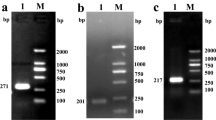Abstract
The isopenicillin-N-synthetase-encoding pcbC gene from the filamentous fungus Acremonium chrysogenum is differentially expressed in strains showing either a high or low cephalosporin C production. For a case study to demonstrate heterologous protein synthesis in A. chrysogenum, we have chosen a synthetic 195-bp gene encoding the thrombin inhibitor hirudin from the leech Hirudo medicinalis. The hirudin gene was fused with the 5′ and 3′ regions of the pcbC gene, resulting in four different expression vectors, which we named pHIR1 to pHIR4. In order to achieve secretion of the heterologous polypeptide, two out of four vectors carry, in addition, secretion signal sequences of an alkaline protease gene originating either from Fusarium sp. or from A. chrysogenum. After DNA-mediated transformation of the two A. chrysogenum strains, transformants were further analysed on the transcriptional and translational level. Irrespective of the vector used for transformation, all transformants show a hirudin-genespecific transcript in Northern hybridizations. In further analysis, hirudin synthesis was determined with a thrombin-inhibition assay, but was detectable only in those strains carrying expression plasmids with the secretion signals. In this case, hirudin was secreted into the culture medium. Transformants from strains with a high cephalosporin C production showed a three- to eightfold higher expression of the hirudin gene compared to low cephalosporin-C-producing strains. The amount of recombinant hirudin was quantified further by ELISA and Western blotting, using a monoclonal antibody directed against recombinant hirudin. Finally, the time course of hirudin gene expression was investigated in a selected transformant that has hirudin activities of 8.0 ATU/ml culture medium. Northern hybridization experiments revealed the highest hirudin transcript level after 2–5 days of cultivation, showing the strongest signal after 3 days. After 4–5 days, we detected the highest hirudin activity, as was confirmed by Western blotting. The level of heterologous hirudin synthesis in A. chrysogenum is discussed in relation to other eukaryotic expression systems.
Similar content being viewed by others
Author information
Authors and Affiliations
Additional information
Received: 24 December 1996 / Received revision: 28 February 1997 / Accepted: 7 March 1997
Rights and permissions
About this article
Cite this article
Radzio, R., Kück, U. Efficient synthesis of the blood-coagulation inhibitor hirudin in the filamentous fungus Acremonium chrysogenum . Appl Microbiol Biotechnol 48, 58–65 (1997). https://doi.org/10.1007/s002530051015
Issue Date:
DOI: https://doi.org/10.1007/s002530051015



